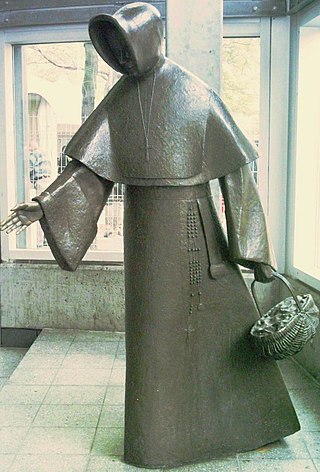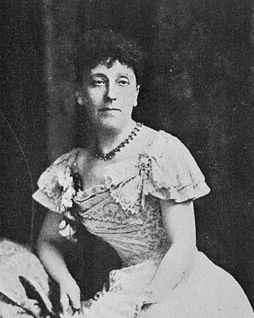Related Research Articles

Jeanne Mance was a French nurse and settler of New France. She arrived in New France two years after the Ursuline nuns came to Quebec. Among the founders of Montreal in 1642, she established its first hospital, the Hôtel-Dieu de Montréal, in 1645. She returned twice to France to seek financial support for the hospital. After providing most of the care directly for years, in 1657 she recruited three sisters of the Religieuses hospitalières de Saint-Joseph, and continued to direct operations of the hospital. During her era, she was also known as Jehanne Mance contemporarily by the French, and as Joan Mance by the English contemporarily.

A hermit, also known as an eremite or solitary, is a person who lives in seclusion. Eremitism plays a role in a variety of religions.
This is an article about literature in Quebec.

The Duplessis Orphans were a population of Canadian children wrongly certified as mentally ill by the provincial government of Quebec and confined to psychiatric institutions in the 1940s and 1950s. Many of these children were deliberately miscertified in order to acquire additional subsidies from the federal government. They are named for Maurice Duplessis, who served as Premier of Quebec for five non-consecutive terms between 1936 and 1959. The controversies associated with Duplessis, and particularly the corruption and abuse concerning the Duplessis orphans, have led to the popular historic conception of his term as Premier as La Grande Noirceur by its critics.

The Sisters of Charity of Montreal, formerly called The Sisters of Charity of the Hôpital Général of Montreal and more commonly known as the Grey Nuns of Montreal, is a Canadian religious institute of Roman Catholic religious sisters, founded in 1737 by Marguerite d'Youville, a young widow.

Ignace Bourget was a Canadian Roman Catholic priest who held the title of Bishop of Montreal from 1840 to 1876. Born in Lévis, Quebec, in 1799, Bourget entered the clergy at an early age, undertook several courses of religious study, and in 1837 was named co-adjutor bishop of the newly created bishopric of Montreal. Following the death of Jean-Jacques Lartigue in 1840, Bourget became Bishop of Montreal.

Marguerite Bourgeoys, CND, was a French nun and founder of the Congregation of Notre Dame of Montreal in the colony of New France, now part of Québec, Canada.

The Congrégation de Notre Dame (CND) is a religious community for women founded in 1658 in Ville Marie (Montreal), in the colony of New France, now part of Canada. It was established by Marguerite Bourgeoys, who was recruited in France to create a religious community in Ville Marie. She developed a congregation for women that was not cloistered; the sisters were allowed to live and work outside the convent. The congregation held an important role in the development of New France, as it supported women and girls in the colony and offered roles for them outside the home.

Marguerite d'Youville, SGM was a French Canadian Catholic widow who founded the Order of Sisters of Charity of Montreal, commonly known as the Grey Nuns. She was canonized by Pope John Paul II in 1990, becoming the first native-born Canadian to be declared a saint.
Lydia Longley (Sainte-Madeleine), an English colonist from Groton, Massachusetts, in the mid-20th century became known as "The First American Nun" from a popular 1958 children's novel about her decades in a Catholic congregation in Montreal, New France.

Jeanne Le Ber was a recluse in New France.
Jacques Le Ber was a merchant and seigneur in Montreal, New France. In 1686 he was ennobled by Louis XIV and took the title Jacques Le Ber de Saint-Paul de Senneville, based on his hometown of Senneville-sur-Fécamp.

Marie-Rose Durocher, SNJM was a Canadian Catholic religious sister who founded the Sisters of the Holy Names of Jesus and Mary. She was beatified in 1982.
The Apostles of Infinite Love is a traditionalist Independent Catholic religious group active in various parts of the world, with its headquarters being in Quebec. It was founded by Michel Collin, a French Catholic priest in Lille, who proclaimed himself Pope Clement XV, after receiving a vision from God crowning him with a papal tiara. Initially heading a religious congregation that had Catholic archdiocesan approval, Jean-Gaston Tremblay merged his religious community with the Apostles of Infinite Love and led it for a time. The Apostles of Infinite Love has attracted traditional Catholics unhappy with changes made during the Second Vatican Council.

Émilie Tavernier Gamelin was a Canadian social worker and Roman Catholic religious sister. She is best known as the founder of the Sisters of Providence of Montreal. In 2001 she was beatified by Pope John Paul II.
The Commission scolaire Jérôme-Le Royer was a Catholic school board located on the Island of Montreal in Quebec, Canada. It oversaw French and English schools in the former independent municipalities of Anjou, Saint-Leonard, and Montreal-Est as well as the city of Montreal's borough of Pointe-aux-Trembles

Émilie Barthe was a Canadian most widely known for the rumours of having an intimate relationship with Prime Minister Sir Wilfrid Laurier. Her son, Armand Lavergne, is thought to be their illegitimate offspring. Later into her life she would become a Catholic nun.

Marie-Josephte Fitzbach was the founder of the Good Shepherd Sisters of Québec.
Jeanne Renaud was a Canadian dancer, choreographer, and artistic director, considered to be one of the founders of modern dance in Quebec. Born in Montreal, Renaud studied music at the École de musique Vincent-d'Indy. She trained in classical ballet with Elizabeth Leese and in modern dance with Gérald Crevier in Montreal. She went on to study with Merce Cunningham, Hanya Holm and Mary Anthony in New York City. In 1948, she gave a recital with Françoise Sullivan in Montreal. She taught dance in Paris from 1949 to 1954. In 1952, she joined with Les Automatistes who had left Quebec for Paris to present a performance at the American Club there. From 1959 to 1965, she was associated with Françoise Riopelle at the École de Danse Moderne de Montréal as dancer, teacher and choreographer. In 1966, she founded Le Groupe de la Place Royale, the first official modern dance company in Quebec, with Peter Boneham; she was dancer, choreographer, artistic director and administrator for Le Groupe until 1972.
References
- ↑ McCauley, Bernadette (2020). Who Shall Take Care of Our Sick? Roman Catholic Sisters and the Development of Catholic Hospitals in New York City. Johns Hopkins University Press. ISBN 9781421429366.
- ↑ Service, Laura Ieraci. "Sainthood cause opened for Montreal laywoman". www.catholicregister.org. Retrieved 2023-10-13.